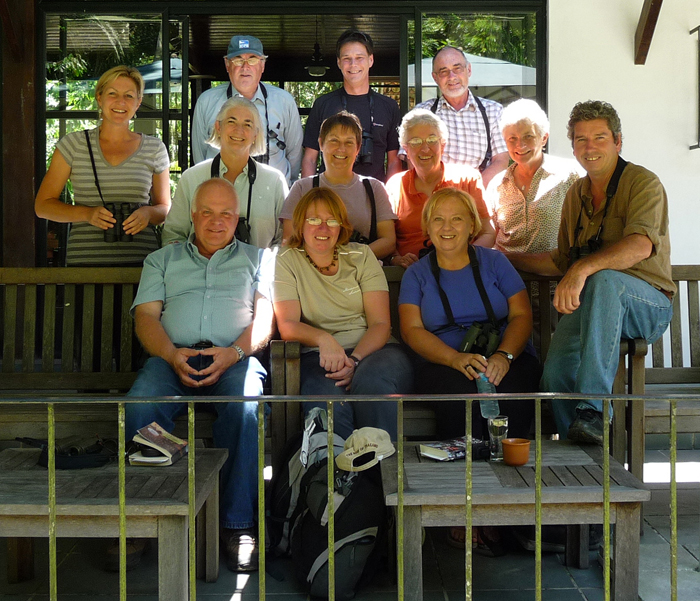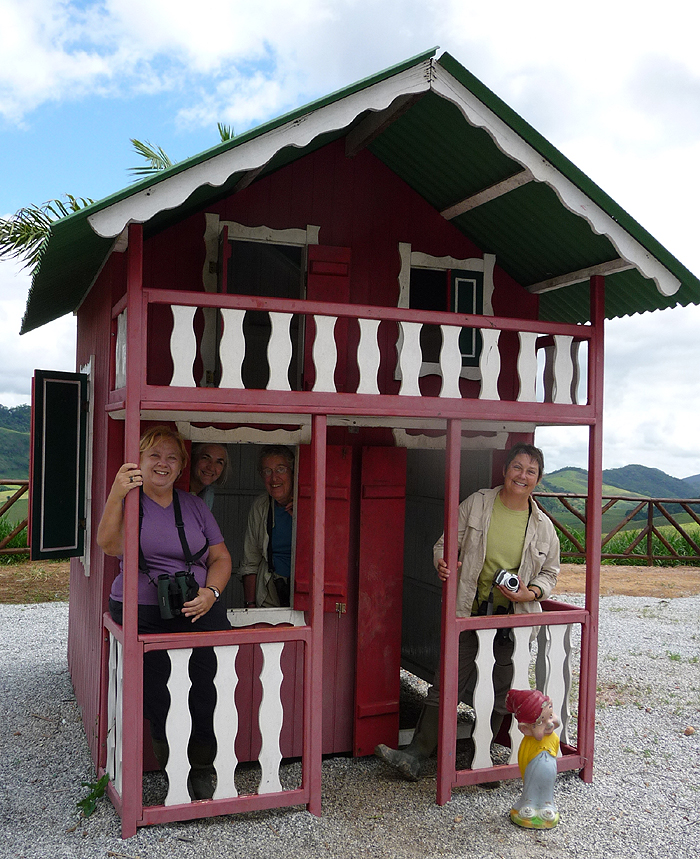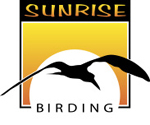 BRAZIL
BRAZIL
ATLANTIC RAINFOREST
November 11 - 19, 2009
Leaders: Gina Nichol, Steve Bird, & Andy Foster
Trip report>> Photo Highlights>>
Species List (pdf)>>
Trip Report
By Gina Nichol & Steve Bird. Photos © the authors. Red text identifies photo.
Days 1 & 2 - Wednesday & Thursday,
November 11 & 12
Penny, Henrietta, Sara and Denise had traveled to Brazil a few days early to enjoy the sights of Rio. The rest of us took a late overnight flight from London that got us to Rio de Janeiro in the morning of Day 2. We met them at the airport and were picked up by our drive Aldo and taken to Serra dos Tucanos lodge in the heart of the Tres Picos State Park in Brazil’s Atlantic rainforest. Along the way, we picked up a some birds from the van including many Magnificent Frigatebirds, Kelp Gulls, Black-crowned Night Heron, Great Egrets, Southern Lapwings and Black Vultures.
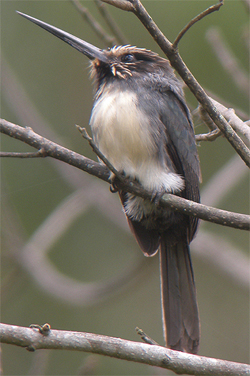
Three-toed Jacamar
Photo by Steve Bird
See more photo highlights
of our two tours to Brazil's
Atlantic Forest in 2009 >>
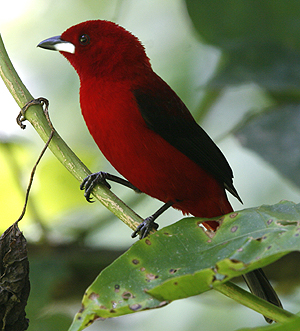 When we arrived at Serra dos Tucanos, we were greeted by Andy Foster, owner of the lodge. We immediately headed for the veranda overlooking the gardens, bird tables and hummingbird feeders. The feeders were buzzing with our first three endemics, the stunning Green-headed Tanagers, Ruby-crowned Tanager, and the bright red Brazilian Tanager. There was so much to see that we swiftly devised a system for getting on to the right feeder quickly to see birds that were called. Black Jacobins buzzed around the hummingbird feeders above our heads and we ticked our first Sombre Hummingbird shortly followed by a Versicolored Emerald. A pair of Pale-breasted Thrushes was busy feeding three chicks in a nest right in front of us and this family kept us entertained with its antics all week. Rufous-bellied Thrush was also seen at the feeders and from then on was a regular, daily visitor.
When we arrived at Serra dos Tucanos, we were greeted by Andy Foster, owner of the lodge. We immediately headed for the veranda overlooking the gardens, bird tables and hummingbird feeders. The feeders were buzzing with our first three endemics, the stunning Green-headed Tanagers, Ruby-crowned Tanager, and the bright red Brazilian Tanager. There was so much to see that we swiftly devised a system for getting on to the right feeder quickly to see birds that were called. Black Jacobins buzzed around the hummingbird feeders above our heads and we ticked our first Sombre Hummingbird shortly followed by a Versicolored Emerald. A pair of Pale-breasted Thrushes was busy feeding three chicks in a nest right in front of us and this family kept us entertained with its antics all week. Rufous-bellied Thrush was also seen at the feeders and from then on was a regular, daily visitor.
After a quick orientation by Andy and his wife Christina, we were back out watching the feeders before lunch. Scopes were out now and Steve put us on some Plain Parakeets perched in a bare tree up on the hill behind the lodge. There were Saffron Finches and Double-collared Seedeaters on the grass and a Gray-hooded Attila came in and perched on a Cecropia tree overlooking the lawn. Other birds visited the feeders including Blue Dacnis and Maroon-bellied Parakeets which were seen on the hanging platform feeder up in the forest. Our first endemic Violet-capped Woodnymph came in and Steve found the nest of another endemic, the Sombre Hummingbird which was in a large tree in the lawn. A tiny female Frilled Coquette was then spotted as it fed on some small white orchid flowers on a tree near the pathway to the pool. The bird raced across the open in front of us and then disappeared but fortunately we all had good views.
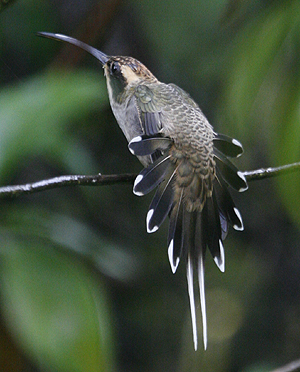 After lunch, we visited the Theodoro Trail and walked, a flat trail at an altitude of 1,100 meters through both secondary and primary forest. As we set off a Spix’s (Chicli) Spinetail showed well and then a Variable Antshrike was seen working the thick undergrowth. Bare-throated Bellbirds were heard calling from the canopy and we scanned the treetops to try and find them but no luck. A Golden-crowned Warbler crossed the path in front of us and as we passed a landslide an some of the group got brief views of a Bare-throated Bellbird perched high up on a dead tree. In another dead tree we scoped an Amethyst Woodstar and then nearby a Blue Manakin crossed in front of us and perched allowing reasonable views. A Southern Caracara was seen soaring overhead and two Savannah Hawks joined it and circled upward into the mist that was dropping in over the ridge toward us. We continued along the trail and picked up Mottled-cheeked Tyrannulet and a female Pin-tailed Manakin while further on a bit of searching for a bird that was calling gave us good looks at a Greenish Schiffornis . Interestingly, it was unusually marked with heavy streaking on the breast so we took some record digishots for study later as it seemed this may well be an undescribed juvenile plumage. An obliging Scale-throated Hermit then perched for several minutes while we studied it and Steve got some cracking photos.
After lunch, we visited the Theodoro Trail and walked, a flat trail at an altitude of 1,100 meters through both secondary and primary forest. As we set off a Spix’s (Chicli) Spinetail showed well and then a Variable Antshrike was seen working the thick undergrowth. Bare-throated Bellbirds were heard calling from the canopy and we scanned the treetops to try and find them but no luck. A Golden-crowned Warbler crossed the path in front of us and as we passed a landslide an some of the group got brief views of a Bare-throated Bellbird perched high up on a dead tree. In another dead tree we scoped an Amethyst Woodstar and then nearby a Blue Manakin crossed in front of us and perched allowing reasonable views. A Southern Caracara was seen soaring overhead and two Savannah Hawks joined it and circled upward into the mist that was dropping in over the ridge toward us. We continued along the trail and picked up Mottled-cheeked Tyrannulet and a female Pin-tailed Manakin while further on a bit of searching for a bird that was calling gave us good looks at a Greenish Schiffornis . Interestingly, it was unusually marked with heavy streaking on the breast so we took some record digishots for study later as it seemed this may well be an undescribed juvenile plumage. An obliging Scale-throated Hermit then perched for several minutes while we studied it and Steve got some cracking photos.
We stopped on an overlook with a vista down into the valley. A Brassy-breasted Tanager was working in the canopy of a large tree, and we waited several minutes in the hopes of seeing the Sharpbill that was calling further away but it did not show. Continuing on, some of us in the back had a Sharp-tailed Streamcreeper that came in close and crossed the trail behind us while an Olivaceous Woodcreeper was being pointed out ahead of us. The mist had now morphed into rain and we walked on at one point forging through a stream running over the path. After a few minutes, the rain let up and by now the stream over the path was flowing volumes. An Azure-shouldered Tanager was a bit of a struggle to see but a Plain Antvireo was much closer and more confiding. White-shouldered Fire-eye and Black-goggled Tanager were next up and a very curious Ochre-faced Tody-Flycatcher came in close to inspect us. As we crossed back over the large landslide a White-throated Hummingbird was seen perched up high on an overhanging dead twig. We headed back to the lodge for the evening and some of us decided to celebrate our first day at Serra dos Tucanos which some Capirinhas before dinner.
Day 3 Friday, November 13
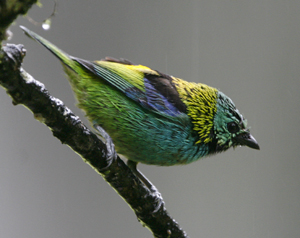 Before breakfast Gina spotted the Blond-crested Woodpecker on the feeders and Denise was lucky enough to be nearby and get good views. Overhead, several White-collared Swifts were seen circling and soon the feeders were hopping with colorful birds including Green-headed Tanager, Blue Dacnis, Maroon-bellied Parakeets, and both Violaceous and Chestnut-bellied Euphonia. A Saw-billed Hermit visited a feeder right in front of us and a Blue-black Grassquit was seen on the grass near the pond at the edge of the forest.
Before breakfast Gina spotted the Blond-crested Woodpecker on the feeders and Denise was lucky enough to be nearby and get good views. Overhead, several White-collared Swifts were seen circling and soon the feeders were hopping with colorful birds including Green-headed Tanager, Blue Dacnis, Maroon-bellied Parakeets, and both Violaceous and Chestnut-bellied Euphonia. A Saw-billed Hermit visited a feeder right in front of us and a Blue-black Grassquit was seen on the grass near the pond at the edge of the forest.
After breakfast we headed for Serra Dos Órgãos National Park. As we stopped for fuel, Janice pointed out a perched Picazuro Pigeon and as we traveled through town, a Swallow-tailed Hummingbird was seen perched on a wire. We arrived at the lower park entrance and were birding as soon as we left the van. A White-barred Piculet was heard calling and there were Saffron Finches on the ground nearby while some very active Streaked Flycatchers moved between the trees above the parking lot. We walked down the park road and soon stopped for a Rufous-capped Antthrush that was calling in the forest. The bird remained hidden for most of us but a pair of Star-throated Antwrens showed very well. We stopped at the next open area and saw Greater Kiskadee, a Red-rumped Cacique in a Cecropia, Squirrel Cuckoo, Piratic Flycatcher, Variegated Flycatcher, and Social Flycatcher as well as a pair of Crested Becards working around a nest. Steve had meanwhile been trying to entice the Rufous-capped Antthrush to come closer and Aldo motioned us to come when he spotted it on the forest floor. We all enjoyed good views of this superb bird amongst the leaf litter. A Red-eyed Vireo created a little excitement just before we continued on down the hill. Around the next big rock, Sara spotted a Sharpbill perched unusually low in a tree and in full view. A Violet-capped Woodnymph was perched on a bare branch in front of us showing well and the next excitement was a pair of Yellow-olive Flycatchers tending a hanging nest full of young. The nest wiggled with the weight of the chicks and the adults visited a few times with food much to our delight. On the next corner, a Unicolored Antwren was seen well and a Lesser Woodcreeper was spotted working its way up tree trunk. A Red-necked Tanager got away quickly but a pair of Flame-crested Tanagers showed well. We continued down to an open area on the side of a rushing river and then started back up the hill toward the entrance. A “wild” Black Jacobin was seen perched on a branch over the road and a Violet-capped Woodnymph did the same on the other side. A nice Whiskered Flycatcher put in an appearance near the Yellow-olive Flycatcher nest and soon we were back up in the open area just before the car park. A White-winged Becard flew over and landed above our heads and a Streaked Flycatcher was seen well perched on a dead stump. Nearby a gorgeous pair of endemic Yellow-lored Tody-Flycatchers were working around a nest in a small tree near the car park and a pair of Chestnut-crowned Becards were also near their own nest. Andy called a Yellow-backed Tanager in the top of a tree but it disappeared quickly 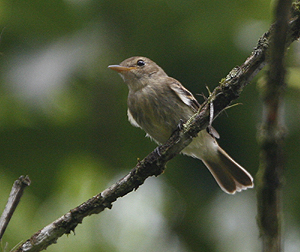 before most could get onto it. Our attention was then diverted to a Buff-fronted Foliage Gleaner working along the branches of a tree up the hill and we all had excellent views of the bird. An Olivaceous Woodcreeper was also seen here and a Sepia-capped Flycatcher disappeared as quickly as it was found. We tried to get into the van to move to our next spot but Steve spotted a pair of Euler’s Flycatchers which had us all back out of the van and enjoying prolonged excellent views. A pair air of Ruby-crowned Tanagers moved through the trees as well before we finally managed to get into the van and move on. We drove up to the Upper entrance of the park and while Andy checked us in, Steve kept us entertained with an attractive lizard that he caught running across the road. One of the American ladies was intrigued by a man in a speedo (briefly) and watched intently while he got dressed even snapping a photo to remember the experience. Once checked in, we drove up to a car park and enjoyed lunch along a stream.
before most could get onto it. Our attention was then diverted to a Buff-fronted Foliage Gleaner working along the branches of a tree up the hill and we all had excellent views of the bird. An Olivaceous Woodcreeper was also seen here and a Sepia-capped Flycatcher disappeared as quickly as it was found. We tried to get into the van to move to our next spot but Steve spotted a pair of Euler’s Flycatchers which had us all back out of the van and enjoying prolonged excellent views. A pair air of Ruby-crowned Tanagers moved through the trees as well before we finally managed to get into the van and move on. We drove up to the Upper entrance of the park and while Andy checked us in, Steve kept us entertained with an attractive lizard that he caught running across the road. One of the American ladies was intrigued by a man in a speedo (briefly) and watched intently while he got dressed even snapping a photo to remember the experience. Once checked in, we drove up to a car park and enjoyed lunch along a stream.
After lunch, we hiked a steep trail into the forest. Our first bird was an excellent White-collared Foliage Gleaner searching out food amongst the dead leaves of some understory trees. White-rimmed Warblers were calling and a Serra-do-Mar Tapaculo was heard but both remained hidden. A Golden-crowned Warbler was much more confiding as was Plain Antvireo and Black-goggled Tanager. A Lesser Woodcreeper caught our attention and a Gray-fronted Dove came in briefly and walked up the track. One of our main target birds a Hooded Berryeater was heard calling on the next corner and eluded some of us as it shot through the canopy and out of sight. Subsequently, a Tawny-throated Leaftosser called loudly and was seen very briefly near the path but also disappeared before anyone else could get on it. Our consolation was fabulous views of a Sharp-tailed Streamcreeper that moved around us and posed at every angle. Fantastic! Further on an endemic White-browed Foliage Gleaner was seen working in a tangle and a Pallid Spinetail flew in overhead, while a Rufous-backed Antvireo called and was eventually seen by most of us before a Black-throated Trogon showed in all its glory. As we came down, a White-browed Woodpecker was watched and then we played cat and mouse with the Hooded Berryeater again, some people getting good views, some getting poor views and some getting none.
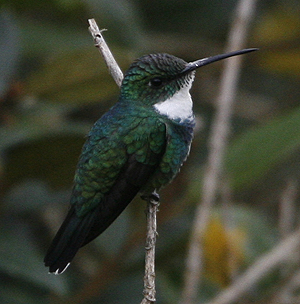 Next up we took the boardwalk trail which was a welcome relief from the steep rocky trail we had come down. A Squirrel Cuckoo showed in some low branches ahead of us and another White-browed Foliage Gleaner was seen along with a nice Olivaceous Woodcreeper working a large open branch overhead. A White-throated Hummingbird perched just above the boardwalk and a nearby Cecropia held a Blue Dacnis and a Yellow-eared Woodpecker. A few Brown Howler Monkeys were feeding in the trees above us and in the background we could hear the unique resonating call of a Bare-throated Bellbird. We reached an open area where we could scan the tree tops and soon fixed on a white form spotted across the valley that looked good for the Bare-throated Bellbird. Gina ran back for a scope and by the time she returned it had been determined that the form was not a Bellbird at all it was a white broken off branch, and this was soon confirmed with the scope. Our consolation was a Swallow-tailed Cotinga that flew in and perched on one tree top, while nearby an Azure-shouldered Tanager was seen on a bare branch. On the way back along the boardwalk a cracking Brazilian Antthrush showed very well just below us, soon followed by a second bird that walked under the boardwalk and then up the bank just a few feet from us. It was time to leave so we headed back toward the lodge. It was now pouring with, but we didn’t mind as we had managed to avoid it all day.
Next up we took the boardwalk trail which was a welcome relief from the steep rocky trail we had come down. A Squirrel Cuckoo showed in some low branches ahead of us and another White-browed Foliage Gleaner was seen along with a nice Olivaceous Woodcreeper working a large open branch overhead. A White-throated Hummingbird perched just above the boardwalk and a nearby Cecropia held a Blue Dacnis and a Yellow-eared Woodpecker. A few Brown Howler Monkeys were feeding in the trees above us and in the background we could hear the unique resonating call of a Bare-throated Bellbird. We reached an open area where we could scan the tree tops and soon fixed on a white form spotted across the valley that looked good for the Bare-throated Bellbird. Gina ran back for a scope and by the time she returned it had been determined that the form was not a Bellbird at all it was a white broken off branch, and this was soon confirmed with the scope. Our consolation was a Swallow-tailed Cotinga that flew in and perched on one tree top, while nearby an Azure-shouldered Tanager was seen on a bare branch. On the way back along the boardwalk a cracking Brazilian Antthrush showed very well just below us, soon followed by a second bird that walked under the boardwalk and then up the bank just a few feet from us. It was time to leave so we headed back toward the lodge. It was now pouring with, but we didn’t mind as we had managed to avoid it all day.
Day 4 - Saturday, November 14
This morning we met before breakfast to watch the feeders and they were humming with the now common Green-headed Tanager , Versicolored Emerald, Black Jacobin, Violet-capped Woodnymph, Maroon-bellied Parakeet, Brazilian Tanager and Ruby-crowned Tanager. Masked Water Tyrants were hunting insects in the lawn as usual and several Gray-rumped Swifts were circling above, while a Black-and-White Hawk Eagle flew over showing mostly in silhouette. We had to tear ourselves away for breakfast and then shortly after, we departed for Pico de Calendonia in search of higher elevation specialties. The drive through the lingerie town was stimulating in its own way and once through town we headed up the foothills stopping for a Cinnamon Tanager on a close tree. The van got us part way up the steep cobblestone road where we then stopped, got out and began walking slowly up birding along the way. The gorgeous blue sky and a light breeze made the strenuous walk more pleasant and the birds certainly did not disappoint. A Rufous-tailed Antbird showed well as it flitted low in a tangle and in the same spot we found a Rufous-capped Spinetail plus one without a tail. At a power line cut there was a male Bay-chested Warbling Finch that showed well and a Golden-crowned Warbler was seen. Just up from that we had cracking looks at a Black-and-Gold Cotinga that was perched up and making its strange piercing whistle call. A not so stunning Serra do Mar Tyrant Manakin showed well for us and a Burnished Buff Tanager was also found. Next up was a Planalto Tyrannulet that disappeared quickly but we got better views later. Overhead we had a dark phase White-tailed Hawk soaring over the hills and as we continued up the views of the stunning landscape got better and better. Our next bird was a Buff-browed Foliage Gleaner that sat obligingly for so long in the open that each of us got excellent scope views. The next corner turned out to be alive with birds so we called it the “corner of dreams” with good views of Red-eyed Thornbird, Diademed Tanager, and Brassy-breasted Tanager.
Continuing on we reached a flat area on another corner of the road where the sought after Gray-winged Cotinga had been seen in the past. It was very quiet bird wise so after awhile some of us decided to continue the walk up the hill to search more of the sprawling habitat. Just a few steps up from the corner, a pair of Yellow-browed Woodpeckers showed well and then Janice spotted a Diademed Tanager which gave very close views. A Rufous-backed Antvireo showed for most of us as did a female Blue-billed Black Tyrant and a Yellow-legged Thrush which was seen in the scope. Along the way there were a few Serra do Mar Tapaculos calling but none of them wanted to be seen. While watching for one particular close tapaculo, a stunning male Plovercrest flew in and landed on some sticks right in front of us and then whizzed off quickly. We got up to an area overlooking a valley where we could scan the treetops and, just as we arrived, a Gray-winged Cotinga popped up into a very close tree where it was seen by Andy and lucky Sara. It dropped down and continued to call so we watched the area for some time but the bird did not show again. After a few minutes, Alan Da. spotted a Plovercrest perched in open view low in front of us and it stayed still for several minutes allowing great views. Scanning the hills continuously, Andy spotted a Gray-winged Cotinga in a distant tree just as the mist rolled in making scope views of the bird impossible. How frustrating was that!
Meanwhile, Penny and Henrietta, who had stayed at the flat corner, decided to start walking back down the hill. Over the radio, they reported that they had found a female Giant Antshrike and seen it well while it preened on a branch. Just then a Giant Antshrike was heard calling where the rest of us were. Eventually the male came in and showed briefly and then the female worked up a tangle into the open and showed very well. Another or the same White-rumped Hawk soared over the valley as we were coming to the realization that our search for the Gray-winged Cotinga was proving futile so we started to head down the hill. We worked our way down toward the corner where we had left Penny and Henrietta and where Alan and Janice had been waiting for us. As we approached we noticed that they were intently looking at something just 20ft away in the forest behind them. As we keyed in on the movement we were amazed to see what turned out to be two Gray-winged Cotingas! How ironic! Some of us go good views while others were less fortunate. We followed the birds into the forest and they dropped out of sight into the valley below. We continued down the road adding Rufous-crowned Greenlet and two White-rimmed Warblers to our day list. A Large-tailed Antshrike was calling and while waiting for that a Rufous Gnateater came through and crossed the road behind us. Eventually we made our way back to the van and reunited ourselves with Penny and Henrietta who regaled us with their story of being picked up by two young men in a truck and driven down the hill. We shared our stories as we drove to another area, where once out of the van, Nick spotted a close Yellow-headed Caracara. We scanned the surroundings noting a Savannah Hawk up on a hillside and a Southern Caracara that flew by carrying prey. We had nice looks at perched Picazuro Pigeon and a Hooded Siskin in a dead tree and then Mick spotted a Red-legged Seriema walking right out in the open along the hillside. Great! Other birds here included Double-collared Seedeater, Cattle Tyrant, Shiny Cowbird, Creamy-bellied Thrush and Campo Flicker. Our birding was slightly interrupted by a cow being brought through the road by a child. Once back on task, Penny spotted a young Swallow-tailed Cotinga on the dead tree and we added Chestnut-crowned Becard, Scaled Woodcreeper and Planalto Tyrannulet before it was time to head back to the lodge.
Day 5 - Sunday, November 15
This morning we woke up to two Blond-crested Woodpeckers visiting the feeders before breakfast, what could be better! As we gathered on the veranda, there was one on the upper feeder and one on the bananas next to the bird hide. Excellent! Both Orange-bellied and Chestnut-bellied Euphonias were also seen along with the regular Green-headed Tanagers and brilliant Brazilian Tanagers. The nesting Pale-breasted Thrushes were feeding their young which were getting bigger each day and it was amazing to see the size of the fruits that the adults were bringing in for them and they were swallowing whole! After breakfast Steve spotted a superb Saffron Toucanet near the upper feeder. It was soon joined by another bird and we enjoyed great scope views of these uniquely colored and much sought after birds.
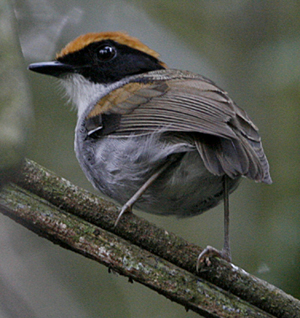 Our birding this morning took us up the trails behind the lodge. As we headed into the forest there were hundreds of White-collared Swifts streaming overhead. A Streaked Flycatcher was seen at our first stop and a little further on there was a Streak-capped Antwren foraging for insects. Blue Manakins were around making a racket and a female Pin-tailed Manakin was seen. A nice Black-goggled Tanager showed for us and an endemic Black-throated Grosbeak was seen well by everyone. We continued along the trail to where an endemic Black-cheeked Gnateater came in very close and gave stunning views, no binoculars needed. A male Pin-tailed Manakin also came in right above our heads and it was a thrill to see these birds so close. Some Crested Oropendolas flew between the trees above us and a pair of Spot-breasted Antvireos showed well. At one point, a six foot long Tropical Rat Snake was seen near the trail and, as we passed, it made its way up a small tree and stretched across between two branches at eye level. Further on, a Scaled Antbird called and showed well and a couple of Rufous-crowned Motmots were seen perched low through the understory. A Ferruginous Antbird came in close and as we watched it flit near the ground a group of White-bearded Manakins popped up nearby. Next up was Lesser Woodcreeper and a group of Red-crowned Ant-tanagers which soon lost our attention as a Spot-billed Toucanet was spotted above us and sat for a long time allowing wonderful scope views. Further on, a female Black-cheeked Gnateater showed well and we caught up with an Ochre-bellied Flycatcher that was calling incessantly near the trail. Walking on, we flushed a Solitary Tinamou that was sat on the ground and continuing back down toward the
Our birding this morning took us up the trails behind the lodge. As we headed into the forest there were hundreds of White-collared Swifts streaming overhead. A Streaked Flycatcher was seen at our first stop and a little further on there was a Streak-capped Antwren foraging for insects. Blue Manakins were around making a racket and a female Pin-tailed Manakin was seen. A nice Black-goggled Tanager showed for us and an endemic Black-throated Grosbeak was seen well by everyone. We continued along the trail to where an endemic Black-cheeked Gnateater came in very close and gave stunning views, no binoculars needed. A male Pin-tailed Manakin also came in right above our heads and it was a thrill to see these birds so close. Some Crested Oropendolas flew between the trees above us and a pair of Spot-breasted Antvireos showed well. At one point, a six foot long Tropical Rat Snake was seen near the trail and, as we passed, it made its way up a small tree and stretched across between two branches at eye level. Further on, a Scaled Antbird called and showed well and a couple of Rufous-crowned Motmots were seen perched low through the understory. A Ferruginous Antbird came in close and as we watched it flit near the ground a group of White-bearded Manakins popped up nearby. Next up was Lesser Woodcreeper and a group of Red-crowned Ant-tanagers which soon lost our attention as a Spot-billed Toucanet was spotted above us and sat for a long time allowing wonderful scope views. Further on, a female Black-cheeked Gnateater showed well and we caught up with an Ochre-bellied Flycatcher that was calling incessantly near the trail. Walking on, we flushed a Solitary Tinamou that was sat on the ground and continuing back down toward the 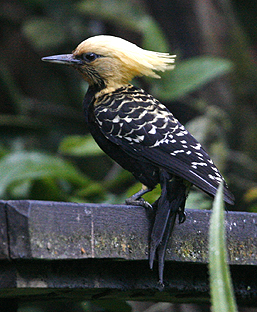 lodge, a pair of White-shouldered Fire-eyes showed well. Back at the lodge some of us walked out to the bridge over the river where a Sharp-tailed Streamcreeper was perched and calling. We had some time so enjoyed a bit of arm chair birding before lunch. Plain Parakeets showed well on the feeders and we had more views of the Blond-crested Woodpecker, Burnished Buff Tanager, Maroon-bellied Parakeet, Brazilian Tanager, Blue Dacnis, and Golden-chevroned Tanager.
lodge, a pair of White-shouldered Fire-eyes showed well. Back at the lodge some of us walked out to the bridge over the river where a Sharp-tailed Streamcreeper was perched and calling. We had some time so enjoyed a bit of arm chair birding before lunch. Plain Parakeets showed well on the feeders and we had more views of the Blond-crested Woodpecker, Burnished Buff Tanager, Maroon-bellied Parakeet, Brazilian Tanager, Blue Dacnis, and Golden-chevroned Tanager.
After lunch our plan was to walk the CEDAE Trail, a wide track leading down a hillside to a river. As we left the lodge, clouds were moving in and there were loud rumbles of thunder. Expecting the weather to close in at any moment, we pressed on and arrived at the top of the trail and started our walk down. There was thick cover on the hill to one side and several huge bromeliad laden trees along the track made for lovely surroundings. As we walked, a White-eyed Foliage Gleaner called but remained elusive. A Green Vine Snake was seen slithering up the hillside and a Violet-capped Woodnymph confidingly perched in the open. Both Red-necked and Green-headed Tanagers flitted in the high canopy and Red-eyed Vireo was also evident. Further down, Yellow-eared Woodpecker, Sepia-capped Flycatcher, and Buff-browed Foliage Gleaner were seen and eventually, we all caught up with the White-barred Piculet. There were several Golden-crowned Warblers around which were easy to see compared to some of the other birds. The thick bamboo tangles on the hillside and the tall trees with numerous vines presented some challenges but we forged on. A Spot-backed Antshrike called but stayed hidden and a White-throated Spadebill showed briefly. An Olivaceous Woodcreeper was seen working a tree trunk near the bottom, before we crossed the river and continued along a flat trail. By now, the sky was clear and sparkling blue and it was time to make our way back up to meet Andy at the designated pickup time. The birding was quiet on the way up but we scored a major victory with nice, very close views of a couple of tiny Eared Pygmy-Tyrants.
Day 6 - Monday, November 16
Heavy rain and thunderstorms overnight made for very wet conditions this morning when we got up and the rain continued as we ate breakfast. After breakfast, we drove to the other side of the mountains to Portao Azul where there was a good chance that it would be dryer. We exited the van, donned our waterproofs and began walking the muddy road. Conditions were getting brighter by the minute with a few light sprinkles and the weather continued to improve as the day progressed. Our first birds were Golden-chevroned and Palm Tanagers in the Cecropias near the road and a Rufous-browed Peppershrike that showed in a low tangle. Some White-eyed Parakeets flew over but were a bit distant and then as we walked to a fork in the road we found an endemic Half-collared Sparrow in a low tree and this attractive bird offered us good views. A Long-tailed Tyrant was spotted in a distant bare tree up the hill and on the other side of the road a Violet-capped Woodnymph came in and posed on a bare twig. We walked up a hill and stopped in a spot 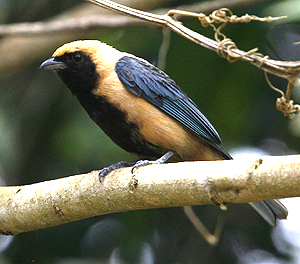 overlooking some coffee fields. A Dusky-legged Guan was very confiding as it perched in an open tree drying its wings. Some noises drew our attention back down the hill a bit to a small stream below the road and we were soon on a Rufous Gnateater perched on an open branch. Continuing on, Steve spotted a Gray-headed Kite perched on a distant dead tree and we scoped it. While we studied the Kite, a Yellow-lored Tody Flycatcher popped up in front of us and both Chicli and Rufous-capped Spinetail were seen in some bushes across the road. A nice Burnished Buff Tanager and Double-collared Seedeater were seen and a couple of Planalto Tyrannulets were flitting around a tree where a Gray-capped Tyrannulet was perched. Ahead of us, an Olivaceous Woodcreeper was working up a bare tree and over the ridge top, a Plumbeous Kite was flying showing the rufous on its wings. Further on, Steve found a Bran-colored Flycatcher and there were some Southern Rough-winged Swallows flying low over the open field. A White-tipped Dove was seen under an open air building but was quickly forgotten when a couple of Magpie Tanagers were spotted in the next tall trees. While watching the tanagers, we noticed some Gilt-edged Tanagers in the same tree and a Fawn-breasted Tanager was also seen but disappeared quickly. Ahead of us a Yellow-bellied Elaenia was busy bringing nesting material into a small tree. We made our way up to a pond that was devoid of birds except for a Striated Heron skulking along one reedy edge. By now the rain had completely stopped and the sky was clearing so some of us dropped off some gear at the van and we continued walking along the road. Birds seen along the way included a White-throated Hummingbird on a perch, a female White-bearded Manakin, and Variable Antshrike. A Green-winged Saltator was heard and then flew in to a tree top allowing distant but reasonable scope views. A Tufted Antshrike was heard at the next corner but never showed and this part of the road proved very quiet. On the way back a very skulky Dusky-tailed Antbird (or parts thereof) offered varying views for most of us. Unfortunately, the female Glittering-bellied Emerald sitting on an open perch above us was all but ignored as we struggled to see the Antbird. We had our picnic lunch near the pond which proved quite productive for birds. Steve found a Hepatic Tanager near the bank behind us and while we were watching it a Hangnest Tody-Tyrant was seen briefly. We searched the area and found a Green-winged Saltator which allowed much better views and while we were looking at it, the Hangnest Tody-Tyrant was also seen again and this time is showed well for us. There were several Creamy-bellied Thrushes around and a pair of White-collared Foliage Gleaners showed well by the van.
overlooking some coffee fields. A Dusky-legged Guan was very confiding as it perched in an open tree drying its wings. Some noises drew our attention back down the hill a bit to a small stream below the road and we were soon on a Rufous Gnateater perched on an open branch. Continuing on, Steve spotted a Gray-headed Kite perched on a distant dead tree and we scoped it. While we studied the Kite, a Yellow-lored Tody Flycatcher popped up in front of us and both Chicli and Rufous-capped Spinetail were seen in some bushes across the road. A nice Burnished Buff Tanager and Double-collared Seedeater were seen and a couple of Planalto Tyrannulets were flitting around a tree where a Gray-capped Tyrannulet was perched. Ahead of us, an Olivaceous Woodcreeper was working up a bare tree and over the ridge top, a Plumbeous Kite was flying showing the rufous on its wings. Further on, Steve found a Bran-colored Flycatcher and there were some Southern Rough-winged Swallows flying low over the open field. A White-tipped Dove was seen under an open air building but was quickly forgotten when a couple of Magpie Tanagers were spotted in the next tall trees. While watching the tanagers, we noticed some Gilt-edged Tanagers in the same tree and a Fawn-breasted Tanager was also seen but disappeared quickly. Ahead of us a Yellow-bellied Elaenia was busy bringing nesting material into a small tree. We made our way up to a pond that was devoid of birds except for a Striated Heron skulking along one reedy edge. By now the rain had completely stopped and the sky was clearing so some of us dropped off some gear at the van and we continued walking along the road. Birds seen along the way included a White-throated Hummingbird on a perch, a female White-bearded Manakin, and Variable Antshrike. A Green-winged Saltator was heard and then flew in to a tree top allowing distant but reasonable scope views. A Tufted Antshrike was heard at the next corner but never showed and this part of the road proved very quiet. On the way back a very skulky Dusky-tailed Antbird (or parts thereof) offered varying views for most of us. Unfortunately, the female Glittering-bellied Emerald sitting on an open perch above us was all but ignored as we struggled to see the Antbird. We had our picnic lunch near the pond which proved quite productive for birds. Steve found a Hepatic Tanager near the bank behind us and while we were watching it a Hangnest Tody-Tyrant was seen briefly. We searched the area and found a Green-winged Saltator which allowed much better views and while we were looking at it, the Hangnest Tody-Tyrant was also seen again and this time is showed well for us. There were several Creamy-bellied Thrushes around and a pair of White-collared Foliage Gleaners showed well by the van.
 From Portao Azul we drover through a town called Sumidouro and stopped by a river flowing through some farm land. Here we found Smooth-billed Ani, White-eyed Parakeet, Snowy Egret and several Cattle Egrets attending their respective cows. The prize here was excellent views of several Three-toed Jacamars flying and perching on some trees up a hillside. A Campo Flicker was also seen here just before the skies opened up forcing a hasty retreat back to the van. On our way back to the lodge, we made a pit stop at a gas station and found a nice Sapphire-spangled Emerald perched on a bush across the road. Another brief roadside stop produced yet another good bird in the form of a male Rufous-capped Antshrike and excellent species to end our day. Unfortunately either for weather reasons or politics we had to give up the idea of a Three-toed Jacamar day, an event that all companies staying at Serra Dos Tucanos enjoy as they try to break any previous existing day records. Our previous tour several weeks earlier smashed the existing record very easily with 124 species in a day and without really trying hard. We were ready to set a new record, but this was not to be as our day had been split into two days. It seems that the thought of this day record going even higher would frighten all our opposition!
From Portao Azul we drover through a town called Sumidouro and stopped by a river flowing through some farm land. Here we found Smooth-billed Ani, White-eyed Parakeet, Snowy Egret and several Cattle Egrets attending their respective cows. The prize here was excellent views of several Three-toed Jacamars flying and perching on some trees up a hillside. A Campo Flicker was also seen here just before the skies opened up forcing a hasty retreat back to the van. On our way back to the lodge, we made a pit stop at a gas station and found a nice Sapphire-spangled Emerald perched on a bush across the road. Another brief roadside stop produced yet another good bird in the form of a male Rufous-capped Antshrike and excellent species to end our day. Unfortunately either for weather reasons or politics we had to give up the idea of a Three-toed Jacamar day, an event that all companies staying at Serra Dos Tucanos enjoy as they try to break any previous existing day records. Our previous tour several weeks earlier smashed the existing record very easily with 124 species in a day and without really trying hard. We were ready to set a new record, but this was not to be as our day had been split into two days. It seems that the thought of this day record going even higher would frighten all our opposition!
Day 7 - Tuesday, November 17
This morning “Blondie” the Blond-crested Woodpecker was once again seen on the feeders and our first gorgeous Blue-naped Chlorophonias were seen before breakfast. After breakfast, we left the lodge in the rain and drove through Lingerie town, always an exciting journey. This would have been our “Jacamar Day” so let’s see how we got on! Beyond town the skies were clear and our first birding stop at an Emergencia sign yielded a family of Fork-tailed Flycatchers, Black-capped Donacobius, Saffron Finch, Bran-colored Flycatcher, Blue-black Grassquit and Glittering-bellied Emerald.
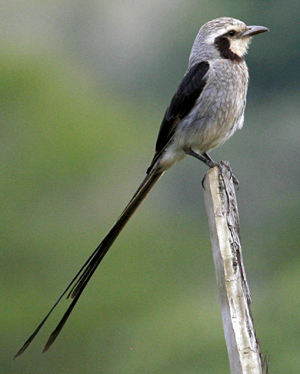 Our next stop was along the road near a farm. On one side of the road was a marshy area with some Chestnut-capped Blackbirds moving among the reeds. Just than a stunning Streamer-tailed Tyrant showed well and flew toward us landing on a fencepost allowing fabulous views. A Blackish Rail was calling from the marsh but never emerged and a Yellow-chinned Spinetail was seen. Overhead, there was another dark morph White-tailed Hawk and above us were some Rufous Horneros near their nest on a power pole. As we continued our search there were Chalk-browed Mockingbirds were around and more White-eyed Parakeets flew over. Moving back across the road toward the van, we spotted a couple of White-rumped Swallows flying over a small farm pond.
Our next stop was along the road near a farm. On one side of the road was a marshy area with some Chestnut-capped Blackbirds moving among the reeds. Just than a stunning Streamer-tailed Tyrant showed well and flew toward us landing on a fencepost allowing fabulous views. A Blackish Rail was calling from the marsh but never emerged and a Yellow-chinned Spinetail was seen. Overhead, there was another dark morph White-tailed Hawk and above us were some Rufous Horneros near their nest on a power pole. As we continued our search there were Chalk-browed Mockingbirds were around and more White-eyed Parakeets flew over. Moving back across the road toward the van, we spotted a couple of White-rumped Swallows flying over a small farm pond.
A few minutes later at our next stop, a pair of Swallow-tailed Hummingbirds flew by quickly and disappeared in the vegetation along the road. Ruddy Ground Doves were seen and there were several Brown-chested Martins flying around, while a scan of the large trees across a field found some Brown-chested Martins perched near a Hornero nest, possibly using it. Andy called a Savannah Hawk that was flying away quickly just before we moved on.
Not far away we stopped near another marshy area along the road. A tree on the edge of the marsh held a Cattle Tyrant next to another Hornero nest, apparently using it. We walked up the road to check the other side and found a lovely Serra Antwren that showed very well for us. Back across the road there was a pair of Common Thornbirds on a stick nest, and Steve decided to try for Blackish Rail as the habitat looked good. To our delight four Blackish Rails emerged from the reed earning Steve a beer from Andy. Yellow-browed Tyrant was also seen in the marsh and there were several Black-capped Donacobius around. Some Yellow-chinned Spinetails came in close to the fence where we were standing and a few Blue-winged Parrotlets were seen in a tree across the road. Our day list was certainly flying along!
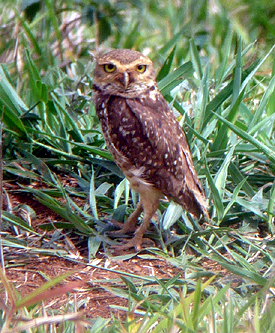 Our next stop was at an open area on top of a hill where there was a petite building with gnomes. A Sooty Grassquit found perched on a fence dropped out of sight quickly but a Grassland Sparrow was much more confiding showed well for several minutes from its fence top perch. Nearby American Kestrels flew over the sprawling, hilly landscape and there were two Red-legged Seriemas seen, one walking along with a snake in its mouth. A Crested Black Tyrant hawked insects around the car park and a Burrowing Owl was seen next to its burrow not far down the hill. As we were getting ready to leave, a Tawny-headed Swallow flew straight toward and over us giving head on views. Just before we left a pair of Lesser Yellow-headed Vultures coursed low against a far hillside showing well. With some good birding under our belts we stopped in the town of Duas Barras for some coffee and a sampling of some typical Brazilian snacks.
Our next stop was at an open area on top of a hill where there was a petite building with gnomes. A Sooty Grassquit found perched on a fence dropped out of sight quickly but a Grassland Sparrow was much more confiding showed well for several minutes from its fence top perch. Nearby American Kestrels flew over the sprawling, hilly landscape and there were two Red-legged Seriemas seen, one walking along with a snake in its mouth. A Crested Black Tyrant hawked insects around the car park and a Burrowing Owl was seen next to its burrow not far down the hill. As we were getting ready to leave, a Tawny-headed Swallow flew straight toward and over us giving head on views. Just before we left a pair of Lesser Yellow-headed Vultures coursed low against a far hillside showing well. With some good birding under our belts we stopped in the town of Duas Barras for some coffee and a sampling of some typical Brazilian snacks.
Then we moved on to a dirt road running along some farm fields where a White-browed Blackbird was seen in the grasses beyond some cows. Some noisy endemic Tail-banded Horneros flew up out of the grasses and Black-capped Donacobius were easily seen. A White-tailed Hawk flew overhead and as we moved toward the van, Nick spotted a nice Swallow-tailed Hummingbird perched in a small tree by a house and we all enjoyed great scope views.
Further on, another stop yielded a White-rumped Monjita perched on a distant treetop. A Southern Caracara was calling and another Fork-tailed Flycatcher was seen, while on the right side of the road a Southern Antpipit was heard calling and with a little patience most of us got looks at this little gem as it same down to the edge of the forest. While we were watching for it, a Planalto Hermit whizzed by and some Gilt-edge Tanagers were seen feeding above in the trees. Olivaceous Woodcreeper and Variable Antshrike were also ticked here.
We drove on and stopped to look at a pair of Firewood Gatherers in a stick nest on a dead tree. On the far hill, four Burrowing Owls were seen around one burrow and a White Woodpecker flew across the valley, while nearby there were some Red-rumped Caciques moving around a tree that held their characteristic hanging nests. The Firewood Gatherer tree also held a Campo Flicker and some Saffron Finches earning it “tree of life” designation. A Plumbeous Kite flew over and the pair of Giant Cowbirds that flew by were a bit underwhelming to say the least. Aldo found a Whistling Heron in the marsh below and we all had scope views of this lovely bird, and as we were about to leave, a flock of Guira Cuckoos flew across the grassland to a tree showing their striking flight pattern.
The next stop was near another marshy area across from a cow farm. Mick spotted an Ash-throated Crake in the marsh and a distant White-bellied Seedeater as seen flitting around the grasses. Two Sooty Tyrannulets were seen perched on a wire over a small stream and we got good views of them when they crossed under the road and perched on some grasses along the stream.
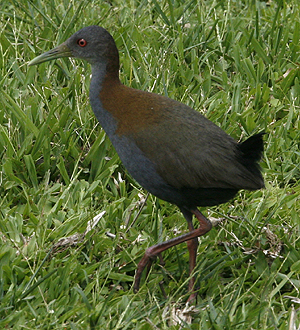 Further on there were some Crested Oropendolas seen and our target Slaty-breasted Wood Rails were heard calling. We were getting hungry and a bit distracted by now but Steve persevered and found a pair of Slaty-breasted Wood Rails not far from the road. A White-eared Puffbird caused one more stop before our late lunch but who needs food when the birding is so good. If this had been our Jacamar Day then by lunch time we were on 94 species!! – the record was on course to be smashed by us again!
Further on there were some Crested Oropendolas seen and our target Slaty-breasted Wood Rails were heard calling. We were getting hungry and a bit distracted by now but Steve persevered and found a pair of Slaty-breasted Wood Rails not far from the road. A White-eared Puffbird caused one more stop before our late lunch but who needs food when the birding is so good. If this had been our Jacamar Day then by lunch time we were on 94 species!! – the record was on course to be smashed by us again!
At our lunch stop there was a White-crested Elaenia and a pair of Blue-winged Macaws that flew into a ridge top and gave distant views. Ruddy Ground Dove and Short-crested Elaenia were seen as were a few Chopi Blackbirds. We headed back toward the lodge stopping at the Macaé de Cima trail. As we got out of the van, we could hear the distant call of a Bare-throated Bellbird and almost immediately Andy had the scope trained on one perched on a treetop across the valley. Another closer Bellbird was eventually seen and scoped and it looked quite good against the background of a clear blue sky. Crested Oropendolas were around and a stunning Rufous-thighed Kite came in and perched on a Cecropia. Above it was a female Violet-capped Woodnymph and after a few minutes the Kite flew down into the valley where it joined a second bird. Fabulous!
After having our fill of the Kites, we moved down the hill and stopped at a corner where a couple of Rufous-crowned Greenlets showed well in a tree next to the road. Olivaceous Woodcreeper and Buff-fronted Foliage Gleaner were also seen in the same tree and a White-throated Hummingbird was perched near a Blue Dacnis on a Cecropia. A Boat-billed Flycatcher showed very well and there were some Golden-chevroned Tanagers around. Overhead Gray-rumped Swifts were flying and a distant gray looking raptor turned out to be a Black Vulture, not a Crowned Eagle as we had hoped.
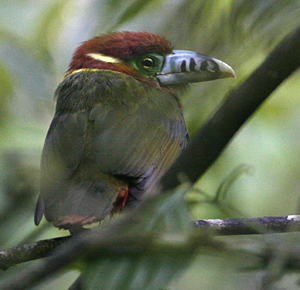 Day 8 - Wednesday, November 18
Day 8 - Wednesday, November 18
During breakfast Blondie once again came into the feeder and just after breakfast, a Spot-billed Toucanet came into the feeder and sat for a long time while we scoped it and took photos. We were late for our departure to Regua, but seeing these birds so well was worth it. We drove down the hill to the valley and then turned off the main road toward the reserve. Some trees around a small pond were completely covered with Cattle and Great Egrets on their nests. A Capped Heron was seen flying across a field and we stopped to take a look at it as a Savannah Hawk took flight from a dead tree. As we scanned the edge of the forest, Steve spotted a Tufted-eared Marmoset working on some low vegetation and we all had varying views of it. Finally arrived at Regua and immediately began searching for the Tropical Screech-owl that is known to perch above the driveway. We searched every tree but no owl was seen until a man on a motorbike stopped and got off and took us around to the one tree we had not checked and pointed out the owl perched against the trunk. With much relief we enjoyed amazing views of this cooperative bird, and the photo opportunities were irresistible.
We walked into the forest along an open trail which was very quiet to begin with but then activity picked up with White-flanked Antwren, White-barred Piculet and a Gray-fronted Dove on the path. A very good in the form of Rough-legged Tyrannulet flew above our heads and was photographed for later verification. Henrietta spotted a Rufous-tailed Jacamar perched on a horizontal branch allowing good views and a pair of Chestnut-backed Antshrikes came in and moved among the leaves of the canopy above us eventually showing well. A Buff-throated Saltator was seen while we were trying to get on the Antshrikes and a Gray-fronted Dove flew in and landed right above us. We continued up a hill where a Sooretama Slaty-Antshrike showed well and a juvenile Long-billed Wren was seen. The trail led across a hillside overlooking a spectacular valley surrounded by mountains and we scanned the landscape for several minutes. Amazingly two Crowned (Solitary) Eagles soared into view garnering gasps from us as they showed very well dwarfing the Black Vultures which were numerous. Fantastic! Back into the forest, we had another Long-billed Wren and a flying visit by a Crescent-chested Puffbird.
By late morning we arrived at a large wetland area and the mid-day sun was starting to heat things up. A Yellow Tyrannulet showed in trees above us and some Green Kingfishers were seen flying over the open water. A few White-faced Whistling Ducks were around as were White-headed Marsh Tyrant, some Purple Gallinules, Chestnut-headed Blackbird and many Common Moorhens. Steve found a young Striped Cuckoo being tended to by Yellow-chinned Spinetails and as we positioned ourselves for scope views, a partially hidden Capybara was seen at the edge of the marsh. We walked the dike between the pools and around one corner found a few Brazilian Teal and saw some White-faced Whistling Ducks in flight as they departed the area. Janice spotted a Lemon-chested Greenlet which turned out to be a family group in the same fruiting trees as a small flock of Swallow Tanagers. As we continued on a group of Greater Anis flew over the far edge of the marsh showing well. It was nearing lunch time so we headed back to the lodge for the afternoon.
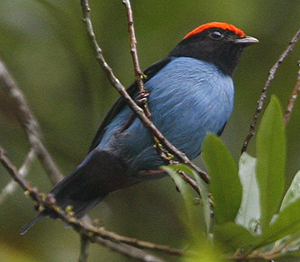 After lunch, we walked up into the forest behind Serra dos Tucanos to catch up on some birds we had yet to see. A White-eyed Foliage Gleaner showed well for everyone eventually and a female White-shouldered Fire-eye was seen in the dark understory. An Eye-ringed Tody Tyrant was a delight to see as it flitted in some low trees and there were several Blue Manakins around, while Lesser Woodcreeper and Plain Antvireo put in appearances before we called it a day.
After lunch, we walked up into the forest behind Serra dos Tucanos to catch up on some birds we had yet to see. A White-eyed Foliage Gleaner showed well for everyone eventually and a female White-shouldered Fire-eye was seen in the dark understory. An Eye-ringed Tody Tyrant was a delight to see as it flitted in some low trees and there were several Blue Manakins around, while Lesser Woodcreeper and Plain Antvireo put in appearances before we called it a day.
Day 9 - Thursday, November 19
Some of us were up and out at 6 AM to make the most of our last morning at the lodge. The sky was clear and blue and the sun was rising over the mountains as we made our way into the forest which was rather quiet except for a Red-crowned Ant Tanager that moved among some large leaves. A White-throated Spadebill was heard and we searched for several minutes eventually hearing another but not seeing either. Meanwhile, a Spot-billed Toucanet was seen perched above us and then we decided to move on to another area up the hill. Once again the White-throated Spadebill was heard, this time closer to us and with some patience we all managed good views of this bird as it came in very near to where we were standing. Fantastic! Further on we had nice looks at a couple of Spot-breasted Antvireos and then headed down to the lodge for breakfast. After breakfast we had some time to relax and enjoy the lodge and after lunch we said goodbye to Andy, Christina, and Aldo and all the lodge staff and set off on our journey to Rio. Eagle eye Steve found a Burrowing Owl for Janice who had missed it a few days earlier and we enjoyed good views Great Egrets and Magnificent Frigatebirds in the waters around Rio. We arrived at the airport late in the afternoon and bid farewell to one another after a bird-filled week in Brazil’s Atlantic Rainforest.
It was a great pleasure to spend the week birding with this wonderful group of people. We enjoyed many excellent views of the areas colorful birds and shared a lot of good laughs as well. Thank you all for a great week! Also particular thanks to Andy Foster for his excellent birding skills and knowledge.
Steve & Gina
Above: Pale-breasted Thrush chick.
